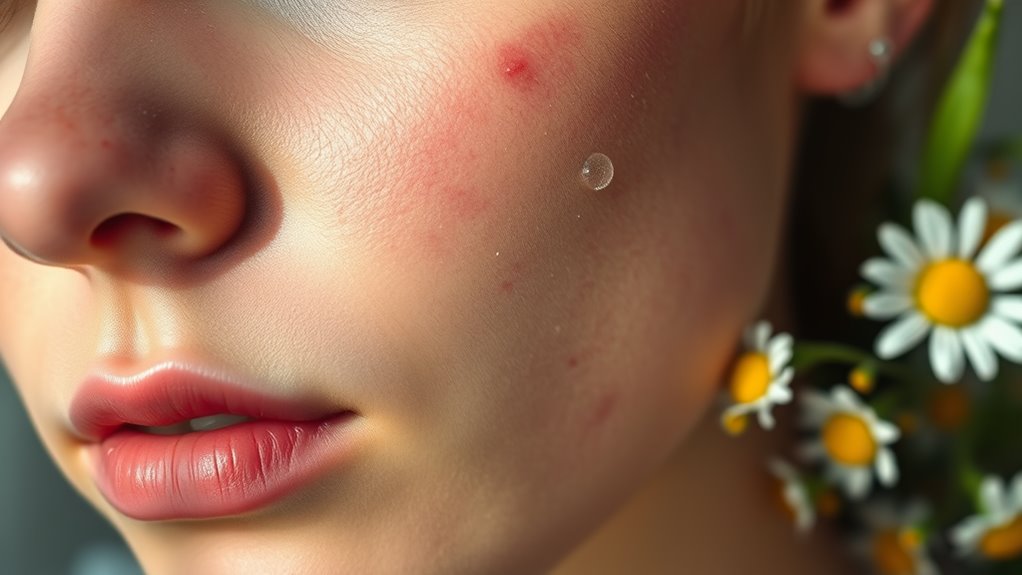The Real Reason Your Skin Is Red-And How to Calm It
Your skin turns red due to various triggers like allergens, irritants, and inflammation, signaling an immune response. This can happen from exposure to harsh chemicals, weather extremes, or specific ingredients in products. To calm it, try applying a cold compress or natural aloe vera for soothing relief. Taking note of your triggers can help manage future flare-ups. Understanding these factors can lead to better care strategies, so explore more about effective treatments and prevention methods.
Common Triggers of Skin Redness
Various factors can trigger skin redness, and understanding these common culprits is essential for effective management.
Allergens like pollen or pet dander can cause flare-ups, while irritants, including harsh soaps or chemicals, may lead to immediate reactions.
Weather extremes, such as heat or cold, also contribute to redness.
Stress and anxiety can exacerbate skin conditions, further complicating the issue.
Identifying these triggers is vital for developing a personalized redness solution. Additionally, ingredient sensitivities are a significant factor in post-skincare irritation, often resulting from specific components in your skincare routine.
Understanding Inflammation and Its Effects
Skin redness often stems from underlying inflammation, which occurs as the body’s natural response to injury or irritants.
This process involves increased blood flow, leading to swelling and redness in affected areas.
Inflammation can result from various factors, such as environmental stressors, skin conditions, or infections.
You might notice warmth and discomfort accompanying redness, signaling that your immune system is active.
While inflammation serves a protective role, chronic inflammation can lead to skin damage and exacerbate conditions like eczema or rosacea.
Understanding this response is essential for effectively managing and soothing your skin’s redness and discomfort. Soothing red skin can often be achieved using natural remedies from your kitchen.
The Role of Allergies in Skin Irritation
Allergies can greatly contribute to skin irritation and redness, often manifesting as hives, rashes, or contact dermatitis.
When your immune system mistakenly identifies a harmless substance as a threat, it triggers an inflammatory response.
This response releases histamines, leading to swelling, redness, and discomfort.
Common allergens include certain foods, pet dander, fragrances, and latex.
To identify triggers, you might consider keeping a diary of your exposures and symptoms.
Consulting a dermatologist or allergist can provide tailored testing and treatment options.
Understanding your specific allergies is essential in managing and alleviating skin irritation effectively. Additionally, using soothing products that contain calming ingredients can help reduce inflammation and redness associated with allergic reactions.
Environmental Factors That Contribute to Redness
Numerous environmental factors can trigger redness in your skin, often leading to discomfort and irritation.
Extreme temperatures, whether hot or cold, can cause blood vessels to dilate or constrict, resulting in visible redness. Sun exposure may lead to sunburn, exacerbating inflammation.
Pollution, including particulate matter and chemicals, can irritate sensitive skin and provoke an inflammatory response.
Additionally, harsh weather conditions, such as wind and low humidity, can strip moisture, making your skin more reactive.
Fragrances and preservatives in skincare products can further contribute to redness, particularly if you have sensitive skin or pre-existing conditions.
Understanding these triggers is essential for prevention. Moreover, incorporating soothing remedies can help restore your skin’s natural balance and reduce redness effectively.
Effective Home Remedies for Soothing Red Skin
To effectively soothe red skin at home, you can apply a cold compress, which helps reduce inflammation and irritation. Natural aloe vera is another excellent option, as it provides hydration and promotes healing. Additionally, an oatmeal bath can relieve discomfort and calm redness, making it a beneficial remedy for sensitive skin. Moreover, incorporating natural remedies into your skincare routine can further enhance skin recovery and overall health.
Cold Compress Application
A cold compress can be a simple yet effective remedy for soothing red skin.
To apply one, take a clean cloth or towel, dampen it with cold water, and wring out excess moisture. Place the compress directly on the affected area for about 10 to 15 minutes.
This method helps reduce inflammation and constricts blood vessels, alleviating redness.
For added effectiveness, you can use ice wrapped in a cloth, but avoid direct ice contact to prevent frostbite.
Repeat this process several times a day as needed.
Always make sure your skin is clean before application to avoid irritation.
Natural Aloe Vera
After using a cold compress to soothe red skin, consider incorporating natural aloe vera into your skincare routine. Aloe vera is renowned for its anti-inflammatory properties, promoting healing and hydration. You can apply fresh aloe vera gel directly to the affected area, allowing it to absorb for maximum benefits.
| Benefits | Application |
|---|---|
| Reduces redness | Apply twice daily |
| Hydrates skin | Use fresh gel only |
| Promotes healing | Leave on for 20 minutes |
Regular use can enhance your skin’s appearance and provide relief from irritation. Always patch-test before full application.
Oatmeal Bath Benefits
An oatmeal bath can be an effective remedy for soothing red skin, thanks to its anti-inflammatory and moisturizing properties.
Oatmeal contains avenanthramides, which help reduce irritation and redness.
When you soak in an oatmeal bath, the colloidal properties create a protective barrier on your skin, locking in moisture and promoting healing.
This treatment can alleviate symptoms associated with eczema, psoriasis, or general skin irritation.
To prepare, grind plain oats into a fine powder and add it to warm bath water.
Soak for 15-20 minutes, ensuring your skin absorbs the soothing benefits.
Rinse off afterward to avoid residue.
When to Seek Professional Help for Skin Issues
When should you consider seeking professional help for skin issues?
If your redness persists for more than a few days, worsens, or is accompanied by severe pain, swelling, or blistering, it’s time to consult a dermatologist.
Additionally, if over-the-counter treatments fail to improve your condition, or if you notice changes in moles or skin texture, professional evaluation is essential.
Persistent symptoms like itching, flaking, or excessive dryness can indicate underlying conditions requiring medical intervention. Following a specialized routine targeting skin calmness and resilience may also be beneficial in managing symptoms.
Don’t hesitate to seek help for skin concerns that affect your quality of life or cause psychological distress, as early intervention can prevent complications.

